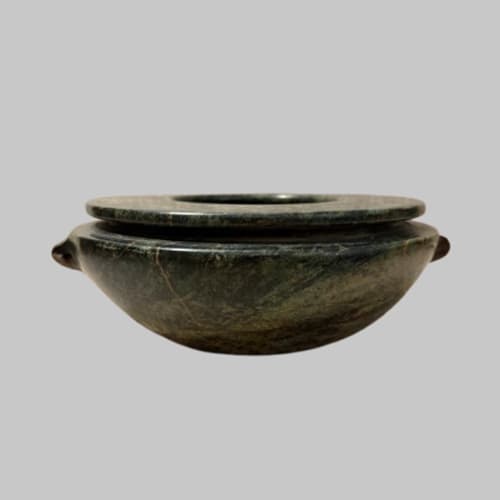Predynastic Lug-handled Vessel, c. 3000 BCE - 2000 BCE
True jewel material
6.3 x 15.2 cm
2 1/2 x 6 in
2 1/2 x 6 in
MK.006
Further images
This extremely light and remarkable workmanship of this predynastic lug-handled vessel, as well as its true jewel material, ensured its durability for the afterlife. It has broad rounded form with...
This extremely light and remarkable workmanship of this predynastic lug-handled vessel, as well as its true jewel material, ensured its durability for the afterlife. It has broad rounded form with twin lug handles and offset everted disk rim. The beautiful, elegant shape looks as fresh and timeless now as it did five thousand years ago. This vessel demonstrates the concern for eternity for which the later Egyptians would become famous.
The stone vessel is the emblematic find from Predynastic tomb sites. After all, stone vessels were durable enough to last for eternity; the pottery vases of everyday life were too fragile and disposable to be of service for the deceased in the afterlife. Some may have contained foodstuffs or cosmetics for the nourishment and enjoyment of the ka (spirit) of the deceased, while others were ritually significant objects in their own right. In the afterlife, the deceased needed analogues of the possessions they used in daily life if they were to enjoy the same benefits after death. Even empty, these vessels served their ritual function. The craftsmanship required to produce such stone vases was significant. The outside of the vessel would be roughly carved, before the artisan bored out the middle of the vessel with a bow-drill. Once this laborious task was complete, the vessel was smoothed with different grades of stone.
The stone vessel is the emblematic find from Predynastic tomb sites. After all, stone vessels were durable enough to last for eternity; the pottery vases of everyday life were too fragile and disposable to be of service for the deceased in the afterlife. Some may have contained foodstuffs or cosmetics for the nourishment and enjoyment of the ka (spirit) of the deceased, while others were ritually significant objects in their own right. In the afterlife, the deceased needed analogues of the possessions they used in daily life if they were to enjoy the same benefits after death. Even empty, these vessels served their ritual function. The craftsmanship required to produce such stone vases was significant. The outside of the vessel would be roughly carved, before the artisan bored out the middle of the vessel with a bow-drill. Once this laborious task was complete, the vessel was smoothed with different grades of stone.
1
of
21







